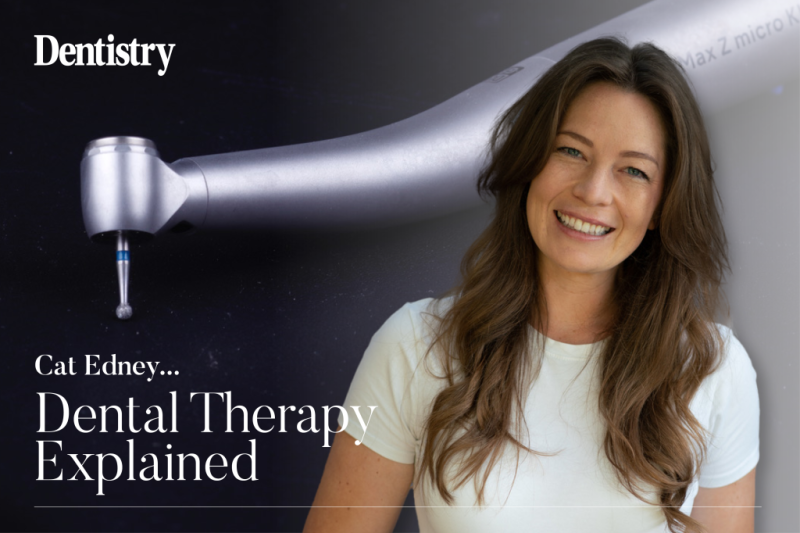How to make dental therapy a success in practice

Cat Edney shares 10 things you need to consider to successfully put dental therapy into practice and get your shared care team working like clockwork.
With modern dental teams embracing shared care, the transition to a dental therapy led practice, or even that of just picking up a fast handpiece again, can be daunting for dental therapists who are getting back into the saddle.
Finding the right pathway to re-develop skills and build confidence can be a minefield, and as every dental practice has differences in structure and patient base, there is no one size fits all solution.
I have compiled a list of ten key things that dental practices and dental therapists can focus on in order to get their shared care teams working like clockwork.
1. Open door policies
Being able to speak to colleagues casually and without fear of judgement has to be the first starting place for any practice that wants to foster a shared care arrangement.
Clinicians need to feel comfortable asking questions, discussing cases and being able to make suggestions. This approach supports team members in collaborating and ensuring that patients get input from multiple clinicians with expertise in different areas of dentistry.
2. Examination template
Notes templates get a lot of bad press – the idea behind an exam template, however, is to incorporate some level of standardisation to the exam process. This means that no matter which clinician sees the patient, all clinicians know where to look in the notes for the information they need.
This standardisation goes deeper when you use training to ensure all clinicians take information in the same way – calibrating clinicians at each stage of an examination improves confidence within the team and ensures that every patient gets the same high quality, team-designed experience.
3. Patient communication goals
Setting out goals for what you want patients to walk away from consultations with can be an empowering way to keep the team focused on gold standard communication.
This can be as simple as ensuring all patients are sent a post-consultation letter explaining their treatment plan – but it can go further: with protocols for patient education including the use of digital software like the Align Oral Health Suite, Pearl Second Opinion and Chairsyde.
It can be helpful for the team to have an understanding of patient learning styles to aid them, and personality typing such as the DISC method will allow you to fully understand what each patient needs in terms of communication.
4. Global treatment planning
Global treatment planning is about ensuring patients are given plans that support long-term oral health. It supports treatment planning for a whole team approach and it starts with the question: ‘What would you like your teeth to be like in 20 years time?’
By working towards a common goal with patients, we move away from firefighting caries and periodontitis and we start looking at how patients can be involved in a preventative and restorative programme for long-term oral health.
5. Referral protocols
If patients are being referred between clinicians, there needs to be some understanding of what the clinicians need in order to accept the referral.
When direct access was brought in for dental hygienists and therapists, the initial trigger for this was to reduce unnecessary costs for patients. Therefore, it is counterproductive to have patients pay consultation fees for routine procedures after they have had a check up with a therapist.
Introducing protocols within the practice which aid clinicians in accepting treatments into their diaries can help with this. There needs to be a conversation and protocol developed around what information each clinician needs in order to accept a referral, ie radiographs, vitality testing, images scans and specific history taking.
The introduction of a tiered system relating to complexity is also helpful alongside the use of digital communication systems and feedback loop learning.
6. Communication systems
We are in a digital age and so it has never been so easy to communicate. There should be easy-to-track communication systems between the team, such as Slack messenger for quick communication, task setting and even the use of messenger groups for managing and updating on complex cases.
Include all clinicians in Whatsapp groups for equipment discussions and an area where cases can be discussed in an informal way and ensure all clinicians contribute to create a meaningful platform for the team to grow and learn together.
7. Digital education equipment and training
I have mentioned this on a number of occasions, but easy, effective patient education is so important that this deserves its own point.
It is ideal in a shared care setting for every patient to have a set of images, digital scans and radiographs for clinicians to view – but taking these records also presents an ideal opportunity for educating patients.
For shared care to be a success, there should be consistency around the way clinicians explain their findings. Using tools such as Pearl Second Opinion can help to calibrate explanations and open patients’ eyes to the diagnostic tools we use in order to treat them.
Team training on the use of digital education can ensure that messages are not lost and that investment equipment such as digital scanners are used to their full potential.
8. Nurse/therapist training
If this is the first time a dental therapist has worked in a shared care arrangement, it may take some time to learn how to utilise the skillset of their nurse to its full potential.
Experience has taught me that by leaning on my dental nurse I can provide far superior examinations and restorations than when I try to take on every role myself.
Consider spending time on training your dental nurse to take full notes, prompt questions that may have been missed from the template, take photographs and scans and also fill conversation gaps while you are creating or editing plans.
9. Financial understanding of cost per surgery per day
Openness around surgery costs, hourly rate and profitability is absolutely key. Dental therapists need to understand how to ensure their surgery and their colleagues’ diaries continue to be profitable.
Team training should include being consistent about zoning the diary, an understanding of time required for clinicians to complete routine procedures, and awareness around booking procedures – how many appointments are required and at what cost.
10. Marketing and website information
The General Dental Council (GDC) make it very clear that the roles and responsibilities of each clinician should be published clearly in practice literature so patients may see them.
It can be helpful to add example patient pathways to demonstrate how shared care works in your practice. It is also important to add what will happen if there is treatment outside of the scope of the dental therapist – where will they refer patients and what the cost implications could be.
Bonus: Language
As a bonus, I wanted to add a note on language. The words our team use to discuss and describe the shared care arrangement are imperative to its success.
For example, change ‘Do you mind seeing the therapist for that?’, to ‘The therapist does these restorations’.
Getting teams successfully utilising a dental therapist has long been a passion project of mine. We often follow a phased approach, including practice specific training and development of protocols so that teams and dental therapists come out confident.
Building confidence takes time and often requires a long-term commitment to mentoring and development. However, these first few points are a fantastic way to start and I hope they will get more teams on the path to putting therapy into practice.
Catch up with Cat’s previous columns:
Follow Dentistry.co.uk on Instagram to keep up with all the latest dental news and trends.







